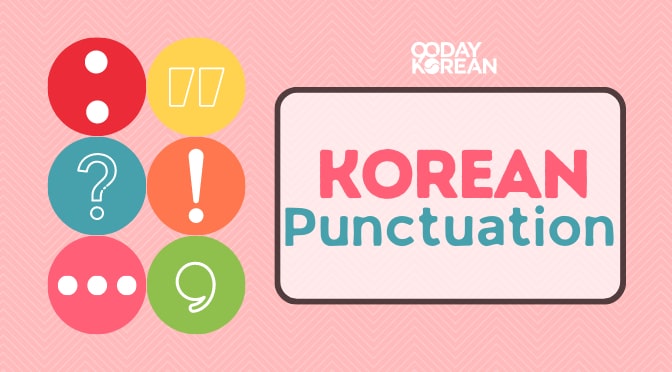Korean punctuation may already look familiar to some of you, especially if you come from an English-speaking nation.
In this lesson, we will quickly and simply go over some of the basics of punctuation in Korean writing.
Korean Punctuation Marks
If you’re planning on composing something in Korean, from school essays to anything else, it is good to familiarize yourself with the punctuation used in Korea, just to be sure you’re on top of it.
This is a part of Korean grammar that isn’t typically taught at the lowest levels, so knowing these early on as you learn Korean may even be advantageous to you.
As you read on, we’ll teach you the commonly used ones you’ll encounter as you learn Korean. Know their differences from each other and how to use them. We’ve added the Korean romanizations of words and phrases in the examples for easier reference if you’re still new to learning Korean.
Punctuation marks in Korean
Punctuation marks in Korean are called 문장무호 (munjangmuho).
Periods (.)
In Korean, there are two purposes for using periods. The first one is to note the end of a sentence. The second is to use abbreviations and dates.
Example 1: At the end of a sentence
안녕하세요. (annyeonghaseyo.)
Hello.
Example 2: Abbreviations and dates
2022. 03. 18.
March 18, 2022
With dates, the period is specifically used when you write the date by using numbers only. The use of periods in the Korean language seems largely similar to how it’s used in other languages, too.
Period in Korean
The Korean word for the punctuation mark “period” is 마침표 (machimpyo).
Commas (,)
A comma is used in multiple instances in Korean in similar ways to many other languages. It can be used in a paired sentence, to list correlated things, or to alternatively separate items from each other.
A comma can also be used to separate clauses within a singular sentence, as well as to reduce phrases that are recurring. Additionally, it can be used after spoken phrases and answers and after some vocabulary that would otherwise end a statement.
Example: To list correlated things
뿌리 채소로는 고구마, 당근, 무, 생강 등이 있습니다. (ppuri chaesoroneun goguma, danggeun, mu, saenggang deungi itseumnida.)
Root vegetables include sweet potatoes, carrots, radishes, and ginger.
Example: to separate clauses within a singular sentence
네, 알겠습니다. (ne, algetseumnida.)
Comma in Korean
The punctuation mark “comma” is called 쉼표 (swimpyo) in Korean.
Question mark (?)
This naturally marks the end of a question. It can be used for any kind of questions, it doesn’t have to be used only when presenting direct questions.
However, if your sentence has more than one question in it, add the question mark only once at the very end.
Example: Used at the end of a question
지금 몇 시예요? (jigeum myeot siyeyo?)
Question mark in Korean
In Korean, the question mark is called 물음표 (mureumpyo).
Exclamation mark (!)
Whenever you want to make an exclamatory statement, finish it with the exclamation mark. This includes sentences that express being surprised, commands, shouting, remarks, and also expressing perfection.
Example: To make an exclamatory statement
잘했어요! (jalhaesseoyo!)
정말 아름다워요! (jeongmal areumdawoyo!)
Exclamation mark in Korean
The Korean word for exclamation mark is 느낌표 (neukkimpyo).
Double quotation marks (” “)
Just like in many other languages, these quotation marks are used to mark spoken words as well as dialogues. It can additionally be used to mark a quoted speech. In addition, they are used to represent different animal sounds.
Example: To mark a quoted speech
식당 주인은 “죄송합니다, 오늘은 예약이 다 찼어요.”라고 말했어요. (sikdang juineun “joesonghamnida, oneureun yeyagi da chasseoyo.”rago malhaesseoyo.)
The restaurant owner said, “I’m sorry, we’re fully booked today.”
Double quotation mark in Korean
In the Korean language, a double quotation mark is called 큰 따옴표 (keun ttaompyo).
Single quotation marks (‘ ‘)
These are used to mark a specific quoted phrase within a quote, as well as to mark one’s thoughts. You can also use it in a conversation to indicate indirect or reported speech by another different speaker. You can just use it to emphasize certain words or a conversation.
Example: To mark one’s thoughts
나는 ‘아직 늦지 않았어.’ 라고 생각했어요. (naneun ‘ajik neutji anasseo.’ rago saenggakaesseoyo.)
I thought, “It’s not too late.”
Single quotation mark in Korean
The Korean word for a single quotation mark is 작은 따옴표 (jageun ttaompyo).
Ellipsis (…)
This one has two uses in written Korean. It’s used to either express the speech trailing off or when there is silence in speech.
Example 1: To express the speech trailing off or when there is silence in speech.
있잖아… (itjana… )
You know…
Example 2: When there is silence in speech
그게 만약 나라면… (geuge manyak naramyeon…)
If that were me…
Ellipsis in Korean
The punctuation mark “ellipsis” is called 줄임표 (jurimpyo) in Korean.
Colon (:)
The colon can also be used in two different ways. First, it can be used to introduce the different parts of a list.
For example, when you are writing about an event, you may use the colon to introduce each separate item like location, date, and so on. You’ll also use the colon to separate hours from minutes when indicating time.
Example: When writing about an event
일시: 2022년 3월 18일 1시 (ilsi: 2022nyeon 3wol 18il 1si )
Date and time: March 18, 2022 at 1:00
장소: 서울역 (jangso: seoullyeok)
Location: Seoul Station
Colon in Korean
In Korean, the punctuation mark “colon” is called 쌍점 (ssangjeom).
Tilde (~)
Continuing the trend of having two uses, a tilde can be used to express a time period or to indicate a distance. In the English language, it would translate as the same meaning as “from X to Y.” But in writing, you can simply use tilde to express the same.
Example 1: To indicate a distance
서울~부산 구간의 기차표는 얼마예요? (seoul~busan guganui gichapyoneun eolmayeyo?)
How much is the train ticket between Seoul and Busan?
Example 2: To express a time period
평균 운행 시간은 2시간 30분 ~ 50분 사이이다. (pyeonggyun unhaeng siganeun 2sigan 30bun ~ 50bun saiida.)
The average driving time is between 2 hours and 30 minutes and 50 minutes.
Tilde in Korean
The punctuation mark “tilde” is called 물결표 (mulgyeolpyo) in Korean.
Slash (/)
With a slash, you can indicate the “per” of measurements such as price, speed, and other similar ones.
Example: To indicate price per unit or person
3,000원/개 3000 (3,000won/gae 3000)
Won per unit
입장료는 19,000원/명입니다 (ipjangnyoneun 19,000won/myeongimnida)
The admission fee is 19,000 won per person.
Slash in Korean
The Korean word for “slash” is 빗금 (bitgeum),
Parentheses (( ))
In writing, parentheses are used to either include additional information within a text or to provide the original word for loan vocabulary taken from other languages.
Example: To provide the original word for loan vocabulary
숭례문(崇禮門)은 서울 4대문(大門) 중의 하나이다. (sungnyemun(崇禮門)eun seoul 4daemun(大門) jungui hanaida.)
Sungnyemun Gate is one of the four gates of Seoul.
Parentheses in Korean
The Korean word for “parentheses” is 소괄호 (sogwalho).
Middle dot (ㆍ)
Lastly, we have the middle dot. This isn’t as widely used among different languages, and it is a recent addition to grammar rules, too. By using this middle dot, one can make lists of similar things or mark significant dates, such as national holidays.
Example: To make lists of similar things
전국의 초ㆍ중ㆍ고등학교 모두 대면 수업을 시작했다. (jeongugui choㆍjungㆍgodeunghakgyo modu daemyeon sueobeul sijakaetda.)
Elementary, middle, and high schools across the country started face-to-face classes.
Middle dot in Korean
In Korean, the middle dot is called 가운뎃점 (gaundetjeom).
Wrap Up
And that’s it for the punctuation marks in Korean. Hopefully, this helps you as you practice writing in Korean!





i have a korean alphabet on my phone but i dont know how to write four letters in one word or whats it called. For example: if i want to write “manh” the n disappears and its just 맣 what should i do??
Hi Dorottya! That is strange, that is usually how we type 많 (ㅁ+ㅏ+ㄴ+ㅎ). You can check your keyboard setting, here is an article that might be helpful: https://www.90daykorean.com/typing-in-korean/
how do i use this symbols^^ in korea
Thanks for your comment! ^^ This emoticon ^^ is used for smiling! You can check out our article on Korean Emoticons: The Ultimate Guide to Text Symbols for more meanings of the various Korean emoticons, and how to use them. If you want, you can also check our blog and visit our YouTube channel for articles and videos with great Korean content.
Do you use a comma when addressing someone like you would in english?
Yes, you can. e.g. 지수 씨, 고마워요 =Thank you, JiSoo.
To get pronounciation is problem for me
Thanks for the comment! If you want to learn how to correctly say Korean letters, words, and sentences, you can read this article called Korean Pronunciation: How to Correctly Say Hangul Letters & Words. You can also check our blog and visit our YouTube channel for articles and videos with great Korean content to improve your pronunciation.